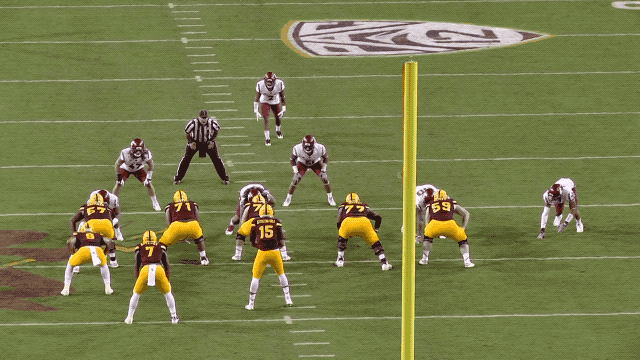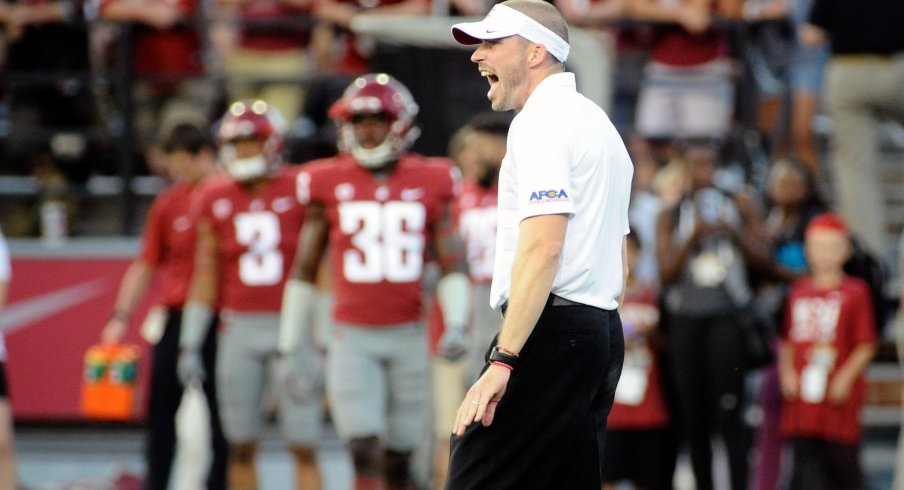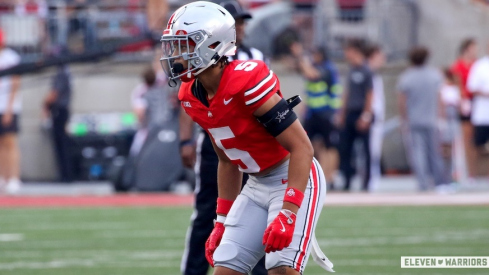For Alex Grinch, it's all about effort.
As the Grove City native settles into his new role with the Ohio State defense, many have wondered what this means for a unit that has finished in the top ten in total defense after each of the past three seasons. Though the former Washington State defensive coordinator's exact responsibilities have yet to be announced, many expect existing play-caller Greg Schiano to move on to a role in the NFL next season, allowing Grinch to fill the top job on Urban Meyer's defensive staff.
Though the 37-year old has only been a coordinator for three seasons prior to his return to Columbus, Grinch is a three-time Broyles Award nominee for good reason. Before he joined Mike Leach's staff in Pullman, the Cougars featured one of the worst defenses in the nation and won only three games in 2014 despite featuring a high-flying offense that threw for over 5,700 passing yards.
But in that short time, Grinch engineered a remarkable turnaround for a unit that is still often overlooked next to Leach's Air Raid offense. Despite a pair of ugly losses to rival Washington in the Apple Cup and Michigan State in the Holiday Bowl to end the 2017 season, the turnaround for the Cougar defense over the previous three years was complete as for the first time in his career as a head coach, Leach's defense finished in the top 20 nationally.
| Year | Yards/Rush Attempt | Yards/Pass Attempt | Sacks | Turnovers Created | YPG Allowed (National Rank) |
|---|---|---|---|---|---|
| 2015 | 4.93 | 6.8 | 32 | 24 | 416.9 (84th) |
| 2016 | 4.08 | 7.9 | 19 | 23 | 405.9 (62nd) |
| 2017 | 4.22 | 6.3 | 37 | 28 | 323.3 (16th) |
Unlike his former boss, Grinch's philosophy isn't espoused in a specific 'system' or schematic philosophy, but rather in the requirement that his team plays with maximum effort at all times. Like Leach's Air Raid offense, though, the WASU defense earned a moniker of their own, as the #SpeedD was always seen flying to the football and gang-tackling opposing ball-carriers.
Though his defense produced a star in All-American defensive end Hercules Mata'afa, Grinch never had the kind of talent at his disposal that he will in Columbus. As Grinch told Stephanie Loh of the Seattle Times back in October,
“We all want them big, fast and ready, but if you’re not able to get those, you have to be willing to compromise something,” Grinch says. “The decision was made that we will not make an athletic compromise."
That philosophy is espoused in a mantra each Cougar defender was taught to practice on every single play:
- Gaps: Identify your gap responsibility in the running game before the snap
- Leverage: Know who is supposed to spill the ball outside, contain the runner inside, or act as the force player to make a tackle on outside runs
- Check-down: Once you've fulfilled your specific responsibilities on the play-call, find the ball-carrier
- Rally: All eleven players must hustle to the ball and attempt to make a play on every single snap
Once the defenders have rallied to the ball, they aren't just trying to make a tackle, they're trying to strip the ball and force a turnover. While some defensive coaches are focused on forcing three-and-outs and others on keeping points off the scoreboard, Grinch matched Leach's aggressive nature by working tirelessly to get the ball back.
As he told Chris Low of ESPN.com in 2016,
“Takeaways equal victories,” said Grinch, whose uncle is former Missouri coach Gary Pinkel. “It’s the only reason we’re out there, to get the ball back for the offense. A lot of people don’t think like that. They look it at more that you’re trying to limit yards. But you’re there on defense for one reason, to get the ball back. If you’re playing defense in basketball, no one is confused as to why you’re playing defense. It’s to get the basketball. It’s the same thing in football.
“We’re trying to brainwash our guys into believing that, so every single practice we’re stripping at it, grabbing at it and trying to knock it loose."
Grinch famously administered his own private study of the effect forced turnovers have on a team's record, predicting that a team that created 24 turnovers would win nine games that season. In 2015, his first season in the Palouse, the Cougars forced exactly 24 turnovers and won exactly nine games, endearing the young coordinator's approach to his players.
But according to them, his relentless focus on effort is balanced by a schematic approach that is easy to digest and understand. Former Washington State linebacker Jeremiah Allison, who played for Grinch in 2015, told the Seattle Times, “Some defensive coordinators, they draw a laundry list of things to do. Coach Grinch has one call and you know what it is,” Allison said. “He can say ‘raze’ and we know that one word has multiple things involved.”
While Grinch claims to run a 3-4 defense on the surface, his unit features diverse personnel allowing him to operate from multiple looks. Instead of two traditional stand-up outside linebackers, the Cougars often featured only one (called a RUSH end) who usually aligned to the boundary and often put his hand on the ground like a traditional 4-3 end. Opposite him was a nickelback similar to the SAM linebacker spot in the current Buckeye defense - a hybrid linebacker/safety player asked to line up in the alley over a slot receiver.
Between them are three 'one-gapping' down linemen who look to penetrate the backfield instead of controlling blockers as they might in a traditional 3-4 scheme. Finally, two inside linebackers and four traditional defensive backs round out the unit with both safeties often lining up in a two-deep shell before every snap.
But if Grinch preaches effort to his players, he's known within the coaching community for his team's late movement just before the snap. While offenses like to gain the upper hand by adding in shifts and motions in hopes of forcing the defense to tip their hand, Grinch's fronts often shift over a gap or two once the quarterback begins his cadence in hopes of sewing chaos along the offensive line with a technique known as stemming.
As he told Loh of the Seattle Times,
“It’s really what offenses do to us. They shift and motion all the time and they do it to make us get less help from the sideline and have less time to process the picture in front of us. It’s commonplace on the offensive side of the ball,” Grinch said. “The idea simply being, to make offenses make decisions late in the cadence and try to eliminate some of the help from the coaching box – there’s a play called, now (we move) and it has to be changed. Which just increases thinking on offense.
“If you can get guys thinking pre-snap, it can give you some semblance of an advantage post-snap.”
That late movement can throw off blocking schemes meant for one alignment by shifting to another with no time to adjust. As seen below, the Arizona State offensive line thinks they'll be blocking a four-man Over front as the quarterback executes a simple zone-read. But what they get from Grinch and the Cougars is a five-man surface that's overloaded to the play-side, filling each gap and leaving the MIKE linebacker free to make an easy tackle.
This late stemming action creates all kinds of issues for offensive linemen leading to false starts...

...and even fumbled snaps as the center panics at the sight of late movement.

Once they're in place, Grinch likes to create more issues up front by constantly stunting and slanting his defensive linemen, throwing off blocking assignments and keeping his inside linebackers clean to make tackles. Though he has countless varieties of these twists, loops, and slants in his arsenal, Grinch follows a pro-style approach to calling them, with a tailored game plan for each opponent based on their tendencies.
Just as Grinch doesn't like to show his hand too early against the run, he also likes to disguise his pass coverages in hopes of baiting a quarterback into mistakes, thus creating more turnovers.
As seen below against top prospect Josh Rosen in 2016, the Cougars line up in their same, basic 4-3 Over front with two deep safeties. With the back to the three-receiver side, the only adjustment Rosen can see is the MIKE linebacker has walked out to split the difference between the tackle and the #3 receiver, a fairly common and conservative adjustment to such a formation.
Once the ball is snapped, though, Grinch's defense splits the field with a different coverage on each side. With three receivers to the field, the secondary to that half runs a variation on pattern-matching Quarters coverage known as Special, in which the cornerback locks up the outside receiver in man-coverage while the nickel and safety employ basic Quarters rules against the #2 and #3 receivers as if #1 weren't there.
Opposite them, the boundary corner and safety run a variation of Cover-2 in which the corner undercuts any underneath routes and can help in the run game, knowing the safety is there over the top to take away any vertical routes. This technique is known as trap coverage (often called Kathy by many coaches) and is one of Don Brown's favorite schemes to call up in Ann Arbor.
This post-snap complexity forces Rosen to hold the ball longer than he'd like while going through his reads before eventually forcing it to a covered receiver downfield instead of taking a sack from a stunting Cougar defensive lineman.
Though he tries to make the play-calls and game-plans digestible for his players, the former third-team All-American safety at Mt. Union's coverage schemes grew more complex over time. Not only were he and his staff able to add more to the playbook as the existing roster became comfortable with the basics, but more talented recruits eventually began arriving in Pullman, looking to become the next Mata'afa and earn Pac-12 Defensive Player of the Year honors.
In Columbus, Grinch will find a cupboard already stocked with blue-chip talent that has received excellent mentorship, not only from Schiano, but from position coaches with excellent track records of producing NFL-caliber talent like Larry Johnson Sr. and Kerry Coombs. Unlike when Chris Ash arrived in 2014 with plans of installing his Quarters coverage, the multiple fronts and coverages offered by Grinch's system will allow he and the staff to highlight the talents of players already on the roster, be it the quick first steps of Nick Bosa and Dre'Mont Jones up front or the versatility of Jordan Fuller at safety.
But though it's still unclear what all will be in the playbook for the 2018 Silver Bullets given the potential addition of another defensive coach should Schiano end up leaving, Buckeye fans can be sure the defense will play with unmatched energy. But knowing what we do about his new boss' own obsession with players going '4-to-6, A-to-B' on every single snap, maybe it shouldn't have come as a surprise that the relatively unknown Grinch was given such an important job.



